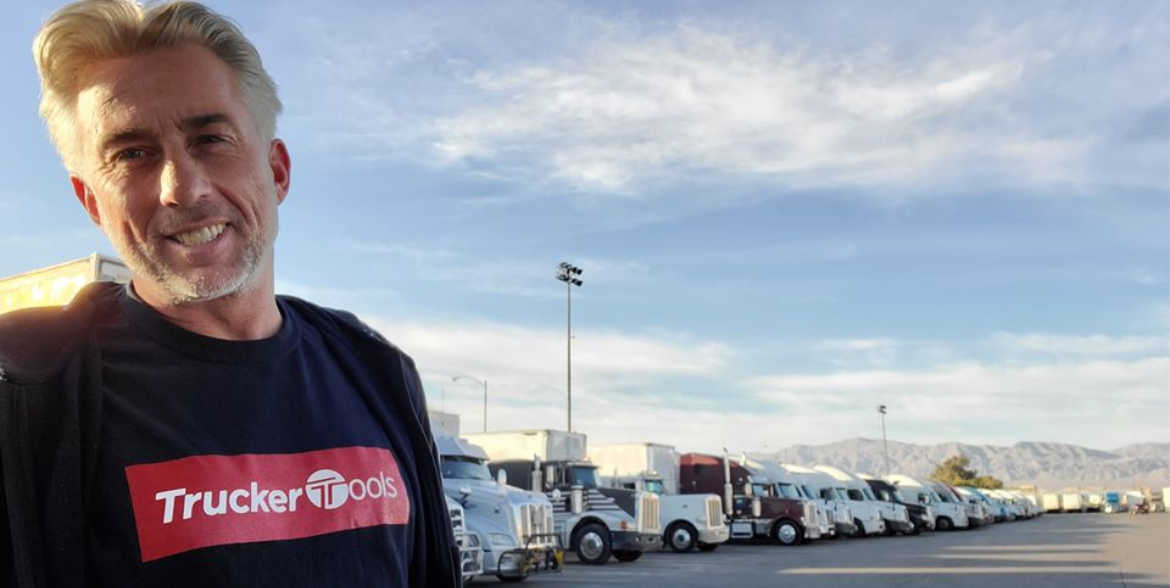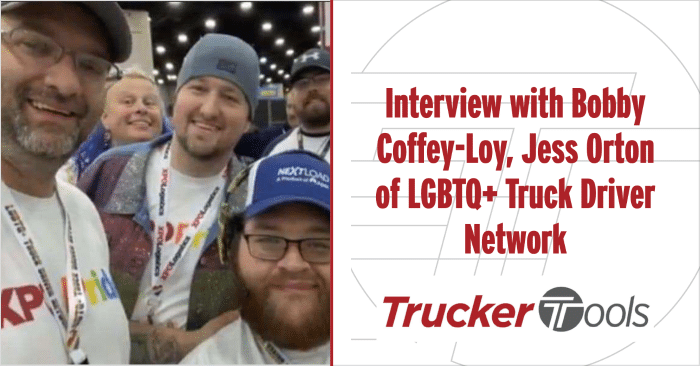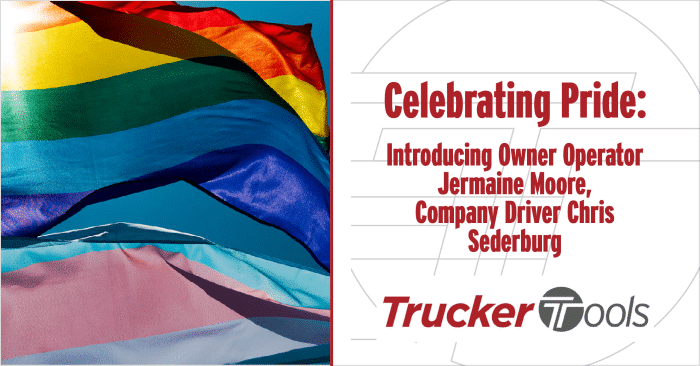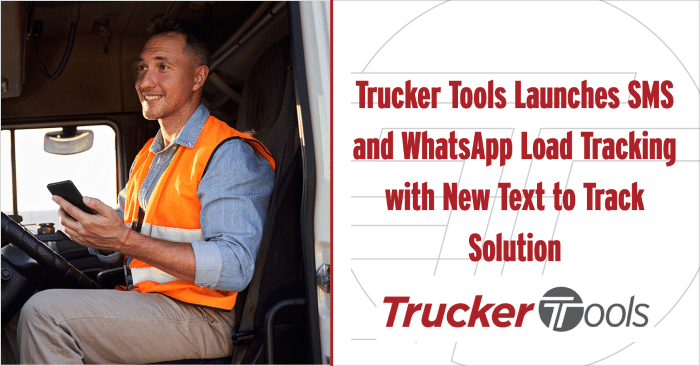We recently had a sit-down with Wayne Campbell of The Driver’s Side to discuss his video series for and about truck drivers and his perspective on the trucking industry. We chatted with Wayne about the many diverse roles he’s held in the industry, from driving for NBA superstar Shaquille O’Neal and running reefer freight to being a lease purchase operator and oilfield driver. During our conversation, Wayne spoke to us about “Inherited Heritage” in trucking and what veteran truckers and the young drivers just coming into the industry can learn from one another. Wayne also shared his thoughts on how technology like Trucker Tools’ driver app can help all drivers work smarter, not harder when they’re on the road.
Can you tell our readers a little bit about yourself and how you got started in trucking?
“I’m no longer in the seat. I worked for my dad as a young man. There’s a lot to my driving career. I went from Hollywood to over-the-road to oilfield. I’ve done a lot of different things in the transportation industry.
Growing up with my dad who worked in transportation for the movie industry for 20 years, I was what they call a studio brat. I just ran around the studio while my dad and his drivers were working. So I’d get on bikes and ride around Universal, Warner Brothers and Paramount studios and I’d get into things. I was just a kid that got into things. People liked me and I met a lot of great people and had a lot of great opportunities in my life at a young age.
In my 20s, I worked for NBA basketball star Shaquille O’Neal for a lot of years and he’s a good friend of mine. When you work for somebody on that level, it’s a different world. I was young and I got too much too soon, as my dad said, and I forgot where I came from. I actually lost the opportunity and made some bad choices in my life. As I went through my 20s, I really lost my way and lost touch with who I was. I had to rebuild and now I’m back. That’s why I ended up in trucking. I used to work in the movie industry with my dad and my dad worked on a movie with Shaquille and that’s how I met him. I kind of said, ‘Oh, well, Dad, I don’t need you anymore.’ And Shaq and I had a falling out and then I wanted to go back to working with my dad, but he was retired by that point. So I wound up in trucking school. I’m still friends with Shaq to this day and that relationship is back to being healthy. It was tough to rebuild myself, but it was worth it because here I am today talking with you guys.
When the time came for me to rebuild my life, I went back into the transportation industry. I didn’t have my CDL, so I was forced into trucking school. I went to CR England, where I learned about the mainstream of trucking outside of my history with my dad. I’d worked for my dad as a kid, but I’d never obtained my CDL for the big trucks. So I went to CR England and became a driver. I remember that it was Christmas Eve in 2008 when I hit the road with my CDL and my trainer. My life changed from that moment on when I became an actual truck driver. Well, I thought I was driver! I had a lot to learn, but that’s how I obtained my CDL — through a big school.”
Can you explain what an oilfield driver is, for those who maybe aren’t familiar with that area of trucking?
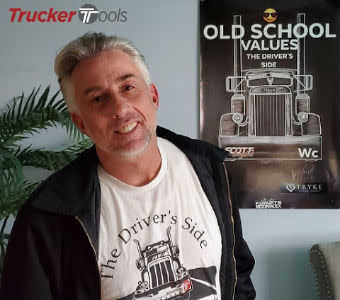
“After I was done with CR England, I went through a lease purchase program, which I didn’t have a good experience with. I wound up moving to Texas with my former wife, who was American’s first deaf female truck driver. When we moved to Texas, she was filing out applications and her being deaf, I would have to take the phone calls for her interviews. She filled out an application for a company called Chalk Mountain and they talked to me and wanted to meet her and met her, and she got the job. In that process, they asked me if I had a CDL and I said yes, but I wasn’t really looking to drive and I passed on the opportunity. My wife at the time took the opportunity and did very well.
I wound up quitting my job where I’d been working at Albertons and went right back into trucking because I saw her paycheck. I got into hauling frack sand, which was a whole new experience for me. I’d been hauling reefer and dry van prior to that. The oilfields were a great experience for me. I went from homeless to homeowner as an oilfield driver and it was really good to me.”
You mentioned earlier that when you started driving, you realized that you loved it. What did you like most about driving?
“The drivers — being around drivers like I had been with my dad. Certain places in the country where I’d stop, like White’s Truck Stop, it felt like I was with my dad again. But I was grown, driving a big truck. I felt like I was part of something, you know, moving America. That was special to me.”
“The drivers — being around drivers like I had been with my dad. Certain places in the country where I’d stop, like White’s Truck Stop, it felt like I was with my dad again. But I was grown, driving a big truck. I felt like I was part of something, you know, moving America. That was special to me.”
On the flip side of that, what was the hardest part of being a truck driver?
“The hardest part was that I was raised to always be a professional. I’ve always carried myself in a certain manner. Seeing other drivers that just didn’t care about the industry — that was the hardest part. They didn’t really realize what it’s all about, which is working together out there in the same space. It’s a big country and when you move across it, you run in the same lanes with a lot of people. The sad part was the lack of old school respect, drivers talking and being good to each other, and respecting each other — the lack of camaraderie.”
Is that part of why you became active on social media and developed The Driver’s Side, to build that camaraderie?
“Yes! That was always my number one goal, to build a platform where actual drivers can go and gather. Because in this industry, there’s this thing called a brother and sisterhood. A lot of people say they’re in the brother and sisterhood, but truck drivers who are in this industry and have made a living in this industry know exactly what I’m saying when I say the brother and sisterhood. It’s not just a job. It’s a livelihood. It’s a lifestyle within a career, as opposed to just a job. The professionals in the industry need to be highlighted. They need to be recognized. That’s what I’m trying to do to boost the camaraderie. Also, I want to let drivers know that I know what they’re going through and I’m going to come out there and talk to drivers and highlight the professionals within this industry.
I just celebrated my birthday and it was a year ago on my birthday that I started filming. Today, where I’m at with The Driver’s Side, is truly amazing. It’s from hard work that I’ve been able to work with companies like Trucker Tools. And I’m proud of that. I have a Driver’s Side podcast coming soon. The buzz is going to get bigger. I’m gathering a panel of drivers, including owner operators and carriers — from the rooter to the tooter — and one of the guys, Gary Jones from SPB Trucking, is actually using your app for the St. Louis Rams’ stadium. I’m prepping this to be the best show that trucking has ever seen. I’m going to have a panel of drivers that will give back to the industry and let drivers know how to find an elite company to work for, show them what tools they should use and how to understand and read a load board.
The people that I work with, they are what I call elite fleets. They don’t get on social media platforms to be highlighted. But because I’m doing it from the heart and I’ve been in the industry for a long time, they’re willing to talk to me. For example, I didn’t know Gary from SPB. My partner, Rob, told me that Gary doesn’t usually do interviews and he’s a quiet person. I didn’t know it.”
You have a video series called Inherited Heritage. Why do you think it’s so important to bridge the gap between folks who are newer to the industry and veteran drivers who’ve been in the industry for years?
“There’s a big friction between the old school drivers and the new school drivers. Just because someone’s been in the trucking industry for a year, it doesn’t mean that they’re better than someone who’s been doing it for 20 years. When you go into a career, you try to be the best at that career, the best that you can be. You have your professionals, you have the elites within the industry that haul some of the most precious things that we have.
The reason why I created Inherited Heritage is because being able to work in this industry was a gift for a lot of the people. It was given to them from their parents, like it was from my father. What I learned from my father, growing up, wasn’t the fact that he was a driver, but it was about how important the driver is and how the driver is needed, no matter what. Nothing happens without the driver.
As a kid, I would see my dad working on movies like ET and Return of the Jedi and I would see these movies being made and it was all happening because the driver brought it. The driver was always the first one to be there and the last one to leave. Whenever there was a problem, they went to the drivers and it was just an amazing thing. The work ethic that was given to me from my father and the men and women that worked for him — I see it everywhere in this industry and people are very proud of it. And it’s not just from the city, it’s also from the farm. It’s a universal work ethic that has been given to a generation that cherishes it.
It’s important that drivers in trucking today know what those drivers went through to get us to today’s trucking. Without them, we wouldn’t be where we are today. Like my wife says, we grew up watching The Jetsons and now we’re giving them The Jetsons. These drivers with all this technology like lane assist, brake assist, autonomous trucking and all this stuff coming out, I understand that times change. But we cannot and I will not allow the men and women that did it before me to not be honored and respected.
As things change, we have to preserve their legacy. With technology, people will be replaced and I understand that if you don’t get with technology, you get left behind. But the ones that get left behind, I feel need to be respected and highlighted as the professionals that they were and the gifts that they gave to so many, like my dad did to me.”
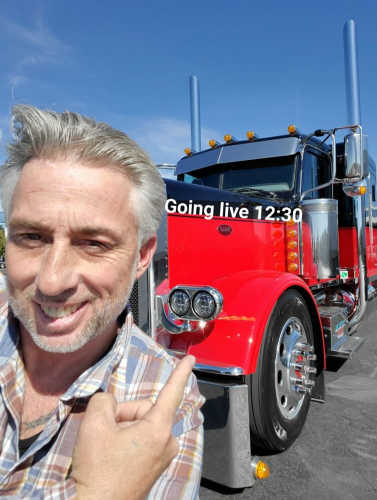
How can the industry ensure that veteran drivers stay on top of new technology and don’t get left behind? How can the industry help them? How can other drivers help them?
“Here’s how I put it: I’m old school valued with a new school twist. The older generation has to realize what these new technologies really are and how much they mean to us. Again, me being married to a deaf woman, helped me understand how important technology really is. The veterans in the industry need to realize that the new drivers coming into the industry, for example from the deaf community, have changed the industry for the better because of technology. These people have an opportunity at a life that they never had before and it’s because of technology.
It’s important for veterans to realize that these new drivers coming into the industry understand technology and if they (veteran drivers) don’t start embracing technology and keep fighting it, they’re going to be stuck and they’re not going to evolve. Technology is just a new tool within their careers that can help. We know that some technologies are taking over and eliminating jobs, but technology also can be used to work smarter, not harder.
Am I going to tell my grandson or granddaughter, ‘Don’t change the world?’ Of course not. We have to look at the flip side of everything. I’ve seen driverless trucks and it’s important to remember that a kid grew up and helped create that technology. Veterans of the industry need to realize that the for the young ones, a keyboard is like a pen to them. For veterans like us, a keyboard is just keyboard.
The older generation needs to reach out to the younger generation for some guidance with technology and then the younger generation has to respect what we went through to get to where we are today. The learning from each other needs to happen, as opposed to, ‘I’ve been doing this for 30 years and you can’t tell me anything’ and ‘Well, I have Google and you can’t teach me anything.’ We can actually teach each other something. I think that’s where the disconnect is. We all need to be more open-minded, especially to technology because it’s here and it’s not going anywhere.
I’m getting ready to launch a show where I can patch people in remotely, like a CNN trucking show. The technology available today is crazy.”
Do think trucking is still an industry driven by relationships?
“You can do all you want with a computer, but a computer doesn’t make an impression, it doesn’t provide service. There’s nothing like a professional that cares, loves what they do, takes pride in it and delivers it in that fashion. You’re not going to get a feeling from a computer, you’re going to get result. You’re not going to get personality. It’s important that people realize that and carry themselves as professionals. It’s hard to find good service today. The human touch and good customer service is still the best.”
When you were actively driving, what kind of tools did you use to make life easier on the road?
“We always used an atlas. I did a lot of team driving with my former wife. She did use other tools, like Live360. That’s how she communicated. She really turned me on to communication. Believe it or not, there were things on our e-log, our black box that we could use for routing and GPS navigation. I used my phone, apps and new technology that was coming out. I had to with my wife being deaf. I started really learning about technology and how she communicated with dispatch through texting and how she used certain apps.”
What are you favorite features in the Trucker Tools driver app?
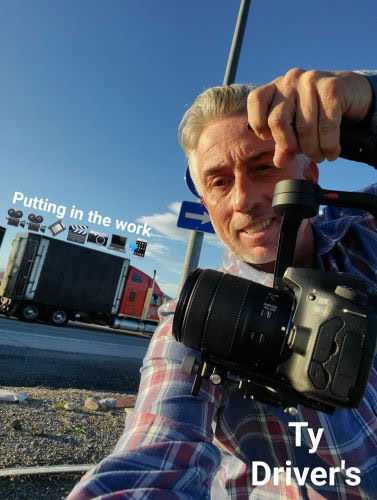
“For me, right out the gate, truck washes. Everybody that I work with loves the truck wash locator feature. Actually, you want to know the truth? This maybe sounds weird, but a friend of mine uses the load tracking in the driver app. He opens it up and he knows it’s all taken care of and he enjoys it, believe it or not.
The people that own fleets understand how important tracking is. It’s important that shippers, receivers, carriers, everybody knows where the freight is. There’s no reason why you shouldn’t because if you use Facebook or Instagram on your phone, those platforms track you. And this is no different. We used to have a guy for that, now we have an app for that. There’s no reason why you shouldn’t have it. I’m finding that drivers that own the companies that are driving the industry actually like it. My friend, John, even said, ‘Wayne, it’s important because what if I have a heart attack on the road?’
Trucker Tools saved me from running out of gas on my way to Texas, I’m not going to lie. I downloaded the Trucker Tools’ driver app and was playing on my phone and I missed my exit. I was in the middle of Arizona. It got me to route 76. That’s the God’s honest truth. There’s no reason for me to lie. From what I’m hearing from drivers and what I see of Trucker Tools, I’m proud to endorse Trucker Tools. It’s important that there’s finally a platform out there for drivers and that is driver-driven.”
Trucker Tools saved me from running out of gas on my way to Texas, I’m not going to lie. I downloaded the Trucker Tools’ driver app and was playing on my phone and I missed my exit. I was in the middle of Arizona. It got me to route 76. That’s the God’s honest truth. There’s no reason for me to lie. From what I’m hearing from drivers and what I see of Trucker Tools, I’m proud to endorse Trucker Tools. It’s important that there’s finally a platform out there for drivers and that is driver-driven.”
Were you ever an owner operator or did you always drive for companies?
“I was an lease purchase operator, but I failed miserably at it. Lease purchase programs are a major issue for me because it’s not a good thing for the industry. It’s really hurting it because 90 percent of the lease purchase programs don’t benefit the drivers. I’m actually going to be covering that topic on The Driver’s Side. We’re going to expose that and how it actually should work.
After being a lease purchase operator, I always worked for good companies. When I went into the oilfields, that’s when I realized that there are some good companies out there like Chalk Mountain Services, which is a family-owned business with a fleet of 25. After that, I went to another company called Bancroft & Sons, where the family literally lived on the yard. I was paid hourly on my last two trucking jobs and that’s the way I would go. I was doing over the road and even local. There are so many avenues in trucking.”
When you were driving, did you have a nightly routine at truck stops?
“Yes, definitely. We always had a routine. Even team driving, you have to stop and you have to shift change. Even when I was training, it was important to set your stops up where you can wash up, brush your teeth, get a cup of coffee, get out and walk around — and not just around the fuel island. You have to do pre-trip and check your equipment. It was routine that I got out every 300 to 400 miles no matter what and got out of that truck and did something that got my blood pumping. You’re seeing it more every day, those coroners at truck stops. It’s sad when you see someone go on the road. It’s not an easy thing to witness.”
Even team driving, you have to stop and you have to shift change. Even when I was training, it was important to set your stops up where you can wash up, brush your teeth, get a cup of coffee, get out and walk around — and not just around the fuel island. You have to do pre-trip and check your equipment. It was routine that I got out every 300 to 400 miles no matter what and got out of that truck and did something that got my blood pumping.
Do you have any tips on how to deal with the isolation of being on the road and ways to still feel connected to your life back home?
“I team drove with my wife, but I had a young daughter at home at the time, a 16 year old, Emily, who is now a mother and I’m the proud grandfather of two beautiful grandkids. Like I said, my wife was very involved with technology. She knew about things that most people didn’t know about, like video chatting. She used video chatting long before most people even knew about it. Also, texting.
You have to get out of your truck and engage, otherwise you’re going to be lonely and just in a small bubble. If you don’t get out of your truck and engage with other people, you’re going to fester and think about nothing but your family and how you should be home. You have to get out of your head and out of your truck. The HOS rules say you have to have a 10 hour break, but that doesn’t mean 10 hours in your bunk.
That means get out, walk around, stretch, get to know your environment and get to know your industry — not just through your phone, but by engaging with other people. What you see on your phone is tailored for you. But in person, every driver’s side is different. That’s why I call my show The Driver’s Side, because every driver is different, and you need to get out and get to know your industry.”
That means get out, walk around, stretch, get to know your environment and get to know your industry — not just through your phone, but by engaging with other people. What you see on your phone is tailored for you. But in person, every driver’s side is different. That’s why I call my show The Driver’s Side, because every driver is different, and you need to get out and get to know your industry.”
Is there something happening in trucking that you’re really excited about or that you think holds a lot of promise for truck drivers?
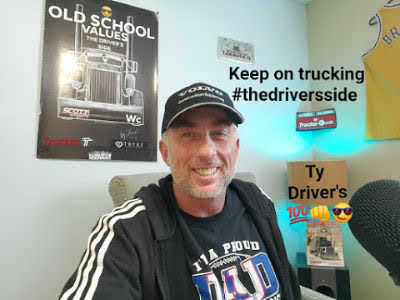
“I’m excited about what I’m doing with The Driver’s Side because it’s not just about me. It’s about the driver and it’s coming from multiple drivers. I’m excited about working with the professionals in this industry who are willing to work with me.
I’m excited about social media and the way that things are going with social media. People can actually make a living through social media — I’m starting to. I love how drivers can go live, though you’ve got to be careful with how you do it — not when you’re driving. I am excited about social media because it lets creators be creators.
I thrive off of social media and I can’t wait to create my next show. I have a jones for it. It’s taken over my life and it’s a lot of hard work. I’ve been broadcasting like this for a solid year and I finally feel like I’m right where I need to be. I’m seeing the results of that hard work that me and my wife have put in. When we go live next time, I’ll be able to have four people call in and have a well put together show. I’m spending money on the production of my shows because if I’m highlighting professionals, I need to be as professional as possible.”
Is there anything else that you think is important for people reading this to know that we haven’t covered?
“Always treat the driver well. Any companies or anyone that hears this, it’s important to know and remember what drivers go through. We know that drivers are the heartbeat of America, but it’s important to know what drivers go through to be the heartbeat of America. I also encourage people to be as professional as possible.”
You can learn more about Wayne Campbell and The Driver’s Side by visiting Wayne’s website and following The Driver’s Side on Facebook. Also look for Wayne and The Driver’s Side at MATS and at CONEXPO later this month.
For more tips from your fellow truckers, check out our interview with third generation driver and enclosed car hauler Jacinda Duran of Jacinda Lady Truck’n.
To download the free Trucker Tools driver app, visit https://www.truckertools.com/carriers/.
